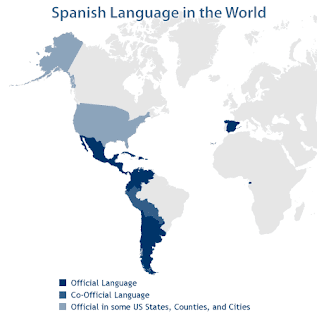
More and more companies are translating their web content and commercial collateral into Spanish. Is this a coincidence?
Of course not, the importance of the Hispanic and Spanish markets should not be underestimated partly due to the fact that the vast majority of this active and expanding market is Spanish speaking only. Below we will discuss some of the more detailed facts of the Spanish market.
Spanish is one of the most widely spoken languages in the world, in fact, after English it is the second most widely spoken language in the world with regard to commercial communication and the third most used on the Internet.
It is estimated that in three generations 10% of the world population will be Spanish speaking and that by the year 2040 the largest Spanish speaking population in the world will be in the united States of America with Mexico next.
Spanish is the second most studied language in the world with 20 million students mainly due to its growing importance in the commercial sector.
All the above points give us some idea as to why so many companies are translating all their commercial collateral into Spanish to take advantage of this huge growing market.
Here are some astonishing facts about the US Hispanic market alone.
• The Hispanic population is expected to account for 44% of the total US population growth before the year 2020 and 62% from 2020 to 2050. By 2050 the current Hispanic population of 44 million is expected to double.
• The average age of the Spanish population is 29 years old.
• Hispanic owned businesses increased 78% between 1985 and 2000.
• The Hispanic market accounted for over 600 billion USD in consumer spending last year.
In these uncertain times where the developed markets are saturated its important to open doors to other opportunities such as the Spanish speaking market. Moreover, translating into Spanish not only opens the door to the Hispanic US market but to another 21 countries in the world that have Spanish as their official language.
Its also important to note that the translation of websites and commercial material is not a straight cut deal where one simply asks the first Translation services company they find to translate everything into Spanish because they are cheap. While the Hispanic market may not be as developed as more established markets, corporate image is still a huge factor in breaking into these markets. Intertwined with Corporate image is the need for quality translation as in most cases a poor quality translation is worse than no translation at all and can destroy the public image of the entity in question. This is why it is so important to hire a translation services company that has experience in providing high quality work in the particular area of expertise in question while also fitting into the companies budget criteria. When requesting a translation quote there is usually a wide range of translation price differences one has to ask why some translation services are so much cheaper than others.
Most of the larger multinationals are already taking this expansion into the Spanish speaking market very seriously but for a lot of the medium and smaller sized companies it is a shame to lose such an opportunity especially in such challenging times?
If you like this post please "like" or "share" for more content
Mark Kieran, CEO, One Stop Shop Translations
For more information on our Spanish translation services click on this link or get an economically unbeatable Spanish translation quote here.

